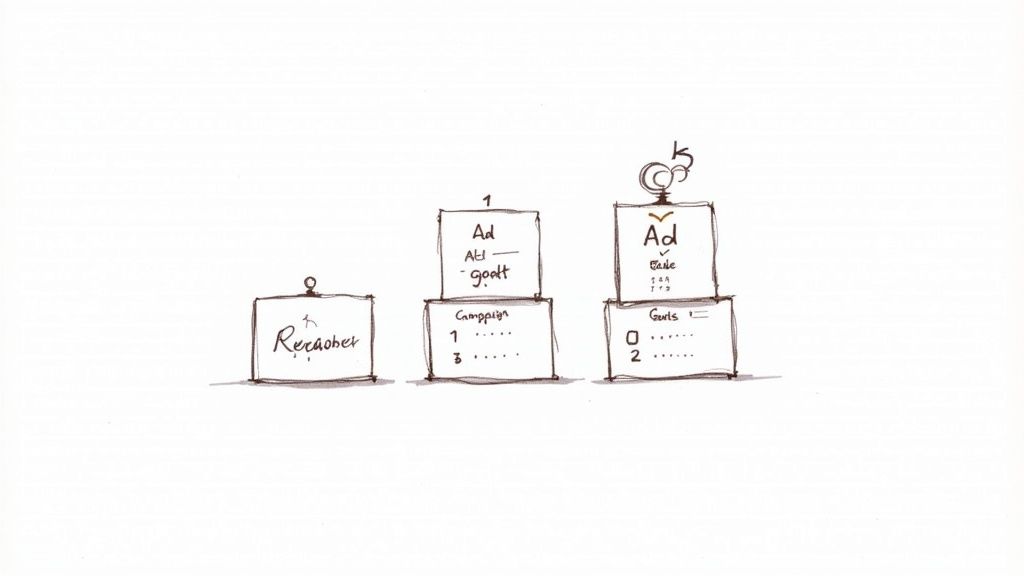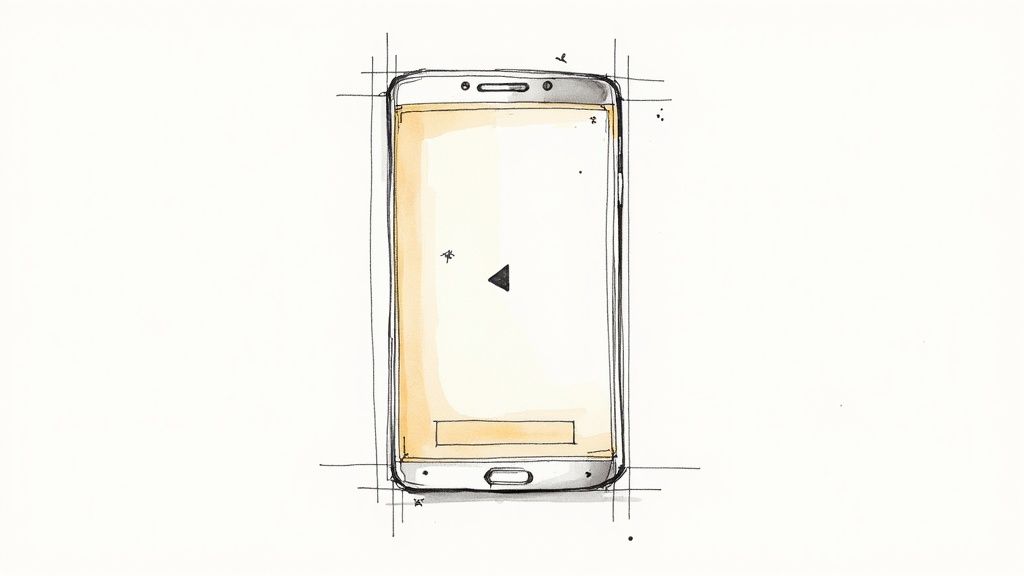
Battling Advertising Fatigue: Strategies to Re-Engage Your Audience
Combat advertising fatigue with strategies to re-engage your audience. Learn to refresh content, optimize delivery, and leverage AI for effective campaigns.

Running a successful Facebook ad campaign is more than just boosting a post. It's a disciplined process of setting smart goals, knowing your audience, creating ads that grab attention, and constantly analyzing data to see what's working. Think of it as a cycle: you test, you learn, you adjust. It's never a "set it and forget it" game.

Before you A/B test a headline or tweak your bids, you must get the basics right. Many advertisers jump the gun and waste money because their foundation is weak. If you want to learn how to optimize Facebook ads for long-term profit, you can't skip these crucial first steps.
Getting this initial setup right provides a logical structure. It makes it easier to test new ideas, scale your winners, and figure out what went wrong when a campaign fails. Without it, you're just throwing money at the wall and hoping something sticks.
Think of your ad account as an organized filing cabinet. When everything has its place, you can find what you need quickly. Facebook Ads Manager has a built-in hierarchy for a reason:
A common mistake is cramming multiple audiences into one ad set. Don't do it. By splitting them up, you get a clear picture of which group is responding, so you can put your money where it will work hardest.
This table breaks down the primary focus and actions you can take at each level of your Facebook ad campaign.
A strong structure is your roadmap. It tells you where to look when things are going great and where to troubleshoot when they aren't.
"I want more sales" isn't a goal; it's a wish. To optimize properly, you need something concrete to measure against.
A better goal is, "I want to achieve a Cost Per Acquisition (CPA) of $25 for all new customer sales." Now you have a specific number. This benchmark transforms a vague hope into a hard data point you can use to make smart decisions.

You can have the most brilliant ad creative, but if it's shown to the wrong people, it's just noise. Real optimization means moving past basic demographics and getting your ads in front of people who want what you're selling. This is how you trim the fat from your ad spend.
Start with what you know. Your most powerful tool is your own data, which you can use to create Custom Audiences. These are warm leads built from:
Once you have a solid Custom Audience, the magic begins. You can ask Meta to create a Lookalike Audience. The algorithm takes your source list—say, your best customers—and finds new users who share similar traits and behaviors. It's a powerful way to expand your reach to people likely to be interested but haven't found you yet.
Here’s a real-world example: A local coffee shop uploads its loyalty program email list. They then create a 1% Lookalike Audience in their city. To take it a step further, they layer on an interest like "specialty coffee."
This combination is key. They aren't just reaching people like their customers; they're reaching people like their customers who also show signs of being ready to buy.
This multi-layered approach is how you find new, high-intent customers. Instead of shouting into the void, you're starting a conversation with people who are already listening.
Campaigns using these methods can achieve a 40% higher conversion rate compared to broadly targeted ads. Lookalike Audiences alone can boost effectiveness by 30%.
The Facebook feed is crowded. Your ad competes with baby photos and vacation updates. To succeed, your creative must do one thing well: stop the scroll.
A powerful visual and compelling copy are your one-two punch. Your goal is to interrupt someone's mindless scrolling with something so intriguing they have to pause.
But how do you figure out what works? You test. Don't assume you know what your audience wants. A/B test everything—headlines, images, videos, and your call-to-action (CTA). A simple change from "Shop Now" to "Learn More" can make a world of difference. Always let the data tell you what's working.
Almost everyone is on Facebook via their phone. This means your ads must be designed for a vertical screen. Formats like Reels and Stories really shine here.
The Facebook Ads Manager has a built-in preview tool that shows how your ad will look across different placements.

Use this religiously. It’s your safety net to ensure your creative looks fantastic everywhere, especially on mobile.
Video is a game-changer. The data backs it up. Video ads, especially in Reels, can pull in a 35% higher click-through rate. Many marketers who've pivoted to a video-heavy strategy have boosted their conversion rates by up to 25% compared to static image campaigns. You can find more stats on Facebook ad performance at cropink.com.
Figuring out how to spend your ad budget is crucial. It's less about having a massive budget and more about making every dollar pull its weight. Your first big decision is between Campaign Budget Optimization (CBO) and Ad Set Budgeting (ABO).
With CBO, you hand the keys to Facebook's algorithm. You set a single campaign budget, and it automatically funnels money to your top-performing ad sets. This is great when you have a winning campaign and you're ready to scale.
On the other hand, ABO gives you complete manual control. You set a specific budget for each ad set. This is perfect for the testing phase when you want to give a new audience a fair shot or guarantee a segment gets a specific amount of your budget.
Your bidding strategy instructs Meta on how to spend your money. The two most common options offer different degrees of control.
A huge part of making your ad budget work smarter is understanding your return on investment. You can learn more about how to measure marketing ROI effectively to nail this down. It's also worth noting that many bidding concepts translate across platforms; our guide on Google Ads bidding strategies offers parallel insights.
Optimizing Facebook ads is a constant feedback loop. Your data tells a story, and the secret to success is learning to read it and make smarter decisions.
First, customize your reports in Ads Manager. Focus on metrics that matter, like Cost Per Result and Return on Ad Spend (ROAS). It's easy to get distracted by vanity metrics like likes, but a campaign with a thousand likes is a flop if it's not bringing in profitable sales.
Also, watch your Frequency metric. If this number creeps up, it's a red flag. Your audience is seeing the same ad repeatedly, leading to ad fatigue and killing performance.
This framework can help you decide where to put your budget.

The right move depends on your goal. For maximum results, focus on volume. But if your main concern is maintaining a specific ROAS, cost control strategies are the way to go.
When an ad campaign tanks, it's usually one of three things: your audience, your creative, or the offer.
Has an ad that was crushing it suddenly taken a nosedive? That's a classic sign of ad fatigue. By keeping an eye on your data, you can figure out whether you need to tweak your targeting, swap in fresh creative, or pause the ad.
For a deeper look at the numbers that count, explore our guide on how to measure marketing ROI.
Even seasoned advertisers run into questions. Let's tackle some of the most common hurdles you'll face.
Hold on! It’s tempting to make changes right away, but you need to give your campaign a chance.
Let your campaign get through Meta’s “learning phase.” This usually takes 3-5 days or until an ad set gets around 50 conversions. Making big changes before then resets the algorithm's progress, and it has to start learning all over again.
Everyone wants the magic number, but it's a bit of a vanity metric. While industry benchmarks float around 1-2%, a high click-through rate (CTR) means nothing if those clicks aren't turning into customers.
Don't fixate on CTR. The real story is in your bottom-line metrics. Focus on your Cost Per Result and Return on Ad Spend (ROAS)—that’s what truly tells you if a campaign is successful.
This is a classic "it depends" situation. Choosing between Campaign Budget Optimization (CBO) and Ad Set Budgeting (ABO) comes down to what you’re trying to accomplish.
If a star performer suddenly tanks, you're likely dealing with ad fatigue. Your audience has seen it too many times.
Check your Frequency score. If it's climbing past 5-7, people are tuning you out. The fix is to hit refresh. Try a new video, a different image, or fresh copy. Another pro move is to duplicate the ad set and point it at a new lookalike audience.
Sometimes, high engagement brings unwanted negativity. Knowing how to disable comments on Facebook posts and ads can be a useful tool in your back pocket.
Ready to stop guessing and start seeing real returns on your ad spend? At BrandBooster.ai, we use advanced AI and proven strategies to deliver measurable results in 60 days—or you don’t pay. Get your free marketing audit today at https://www.brandbooster.ai.